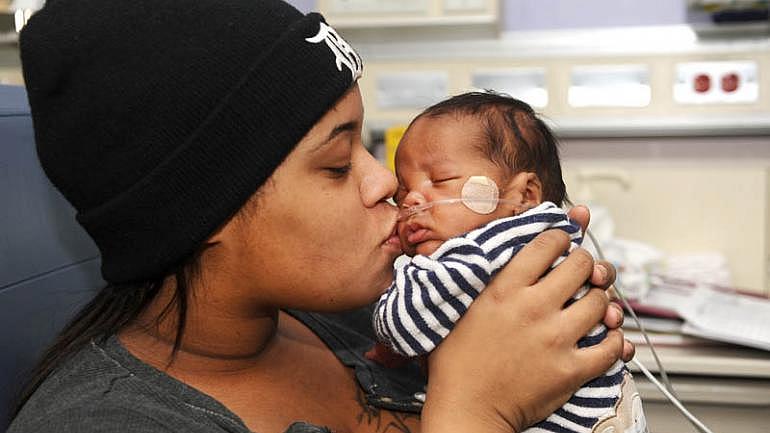Reporting project on child deaths in Detroit garners award

Alaina Gonville kisses her 3-month-old Brandon at the Neonatal Intensive Care Unit at Hutzel Women's Hospital in Detroit. Brandon was born premature through an emergency C-section. (Max Ortiz / The Detroit News)
This week, Karen Bouffard and The Detroit News were awarded a 2015 Communication Award from the National Academies of Science, Engineering and Medicine for Bouffard’s series “Surviving through age 18 in Detroit,” which she reported as a 2013 National Health Journalism Fellow. Bouffard’s reporting revealed that Detroit was the deadliest city in the nation for children, due to high rates of violence and infant mortality.
In recognition of this week’s award, we’re republishing Bouffard’s fellowship essay describing how she reported her series and the resources she found most useful. — Ed.
**
It has not been a secret in Detroit that the city has one of the highest infant mortality rates in the nation and has had for many years. The National Institutes of Health located their Perinatal Research Branch at the Detroit Medical Center in 2002.
As Detroit’s economy plummeted throughout the 2000s, many of its poorest families dropped into destitution. City services, including the Detroit Health Department, were repeatedly slashed. Public health nurses that once visited pregnant and new mothers in their homes dressed in familiar gray uniforms, disappeared. At the same time, state lawmakers continually reduced safety nets for the poor, including cash assistance to needy families.
Initially, I wanted my 2013 National Health Journal Fellowship project to focus on how infant mortality was impacted by Detroit’s economic free-fall. It made sense that as community resources dried up, pregnant mothers would have less access to quality food, housing and medical care. But at the same time, crime increased dramatically in the city, and story after story told of another baby, child or teenager dying of violence. So even if a baby made it through that crucial first year of life, it was clear that children who grow up in Detroit face greater risks of dying before adulthood than their suburban counterparts.
I settled on focusing on the health risks of Detroit children through their 18th year, which became my project -- “Surviving through age 18 in Detroit.”
It seemed reasonable to hope that a child could at least make it safely through high school—though one Detroit police sergeant I spoke with angrily insisted that 17- and 18-year-olds aren’t children. From a judicial standpoint he was right, though I doubt the mother of a 17-year-old killed in a drive-by shooting would agree. I shared his comment with Dr. Herman Gray, vice president of pediatric services for the Detroit Medical Center and a former president of DMC Children’s Hospital of Michigan, and here is what he said: “As a pediatrician, I treat children through age 18, because from a developmental standpoint, they are still children.”
My goal was to compare the child death rate of children in Detroit to that of children in other major cities across the U.S. What I learned is that there is no easy way to get this information. In most states, vital statistics are tracked by county, not by city. The state health department is the repository of this information in most cases, though a small number of cities keep their own data. So for many states I needed to request a special report to get the data I was seeking. One state, Florida, insisted it was impossible to provide the data.
The Kids Count Data Center, a service of the Annie E. Casey Foundation, has child mortality numbers through age 14, but they don’t list death rates—probably because that involves getting population numbers for that age group. Finding population data for the 0-18 age group was the most frustrating part of my project—and it didn’t help that the U.S. Census Bureau was closed due to the government shutdown during part of my research.
The state of Michigan, for example, was only able to provide Detroit population data bundled by age groups, so while I had data on the number of child deaths through age 18, my population data went through age 19. The Michigan Department of Community Health would not separate out that 19thyear. I ultimately discovered the American Fact Finder, a wonderful data base on the U.S. Census Bureau website. For just one year—2010—they had population data for cities by single years of age. By adding up the numbers from each year of age through 18, I was able get the figure I needed. I then went back to the state health departments and requested the total number of child deaths in 2010, with a breakout for the number caused by homicide. Finally, I was able to compare the death rates for children ages 0-18 in Detroit, to the death rates of children in other cities.
Here is the link to the American Fact Finder. Those of you who are familiar with this resource know that you can use it to research an unbelievable range of topics, such as housing and income status, by race, age and geographic location.
